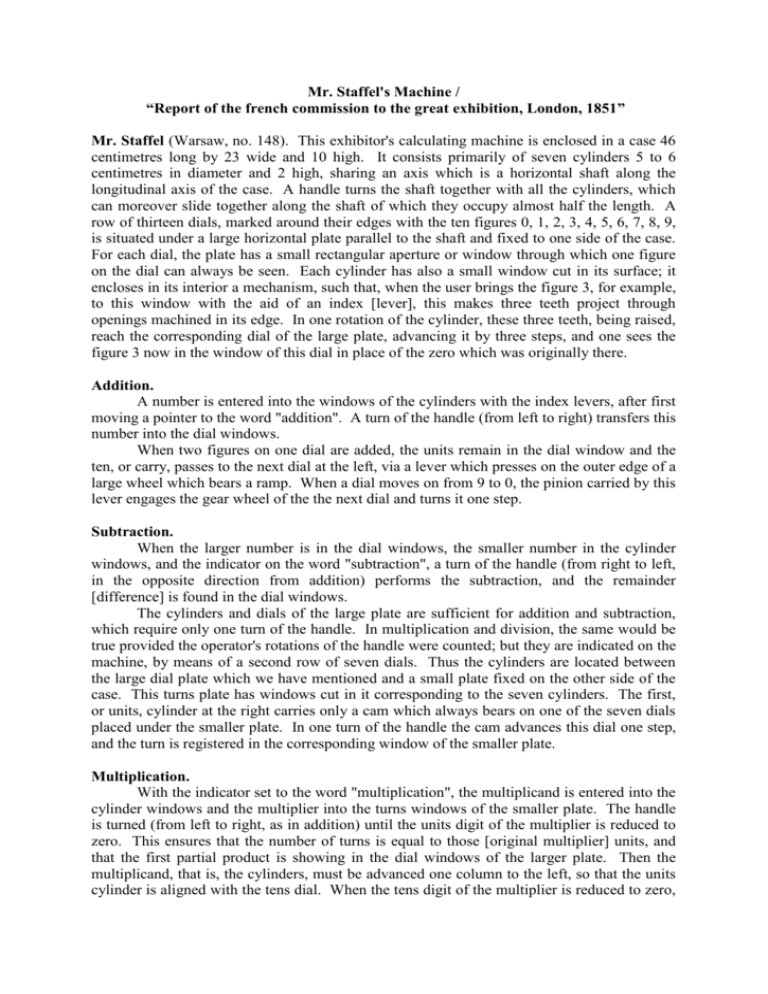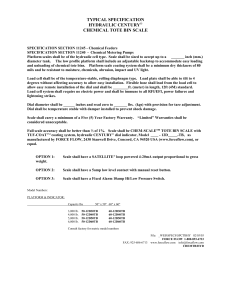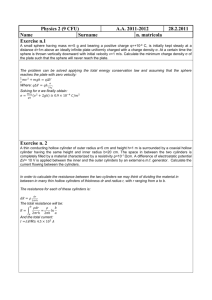Mr. Staffel's Machine / “Report of the french commission to the great
advertisement

Mr. Staffel's Machine / “Report of the french commission to the great exhibition, London, 1851” Mr. Staffel (Warsaw, no. 148). This exhibitor's calculating machine is enclosed in a case 46 centimetres long by 23 wide and 10 high. It consists primarily of seven cylinders 5 to 6 centimetres in diameter and 2 high, sharing an axis which is a horizontal shaft along the longitudinal axis of the case. A handle turns the shaft together with all the cylinders, which can moreover slide together along the shaft of which they occupy almost half the length. A row of thirteen dials, marked around their edges with the ten figures 0, 1, 2, 3, 4, 5, 6, 7, 8, 9, is situated under a large horizontal plate parallel to the shaft and fixed to one side of the case. For each dial, the plate has a small rectangular aperture or window through which one figure on the dial can always be seen. Each cylinder has also a small window cut in its surface; it encloses in its interior a mechanism, such that, when the user brings the figure 3, for example, to this window with the aid of an index [lever], this makes three teeth project through openings machined in its edge. In one rotation of the cylinder, these three teeth, being raised, reach the corresponding dial of the large plate, advancing it by three steps, and one sees the figure 3 now in the window of this dial in place of the zero which was originally there. Addition. A number is entered into the windows of the cylinders with the index levers, after first moving a pointer to the word "addition". A turn of the handle (from left to right) transfers this number into the dial windows. When two figures on one dial are added, the units remain in the dial window and the ten, or carry, passes to the next dial at the left, via a lever which presses on the outer edge of a large wheel which bears a ramp. When a dial moves on from 9 to 0, the pinion carried by this lever engages the gear wheel of the the next dial and turns it one step. Subtraction. When the larger number is in the dial windows, the smaller number in the cylinder windows, and the indicator on the word "subtraction", a turn of the handle (from right to left, in the opposite direction from addition) performs the subtraction, and the remainder [difference] is found in the dial windows. The cylinders and dials of the large plate are sufficient for addition and subtraction, which require only one turn of the handle. In multiplication and division, the same would be true provided the operator's rotations of the handle were counted; but they are indicated on the machine, by means of a second row of seven dials. Thus the cylinders are located between the large dial plate which we have mentioned and a small plate fixed on the other side of the case. This turns plate has windows cut in it corresponding to the seven cylinders. The first, or units, cylinder at the right carries only a cam which always bears on one of the seven dials placed under the smaller plate. In one turn of the handle the cam advances this dial one step, and the turn is registered in the corresponding window of the smaller plate. Multiplication. With the indicator set to the word "multiplication", the multiplicand is entered into the cylinder windows and the multiplier into the turns windows of the smaller plate. The handle is turned (from left to right, as in addition) until the units digit of the multiplier is reduced to zero. This ensures that the number of turns is equal to those [original multiplier] units, and that the first partial product is showing in the dial windows of the larger plate. Then the multiplicand, that is, the cylinders, must be advanced one column to the left, so that the units cylinder is aligned with the tens dial. When the tens digit of the multiplier is reduced to zero, there have been as many turns of the handle as there were tens, and the second partial product has been added to the first, but starting in the tens. One contunues advancing the cylinders one column to the left and turning the handle until all the other digits of the multiplier have been reduced to zero in the turns-counting windows. The products are formed and added as before, and the total product may be read in the dial windows. Division. After entering the dividend into the windows of the large plate and the divisor into the cylinders, the indicator is moved to the word "division"; then the cylinders are slid along so that the divisor which they represent is aligned under the leftmost digits of the dividend. The handle is turned (from right to left) sufficiently to deduct the divisor [as many times as possible] from the first section of the dividend. The number of rotations shown in a turnscounting window is precisely the highest-order digit of the quotient. The divisor, that is, the cylinders, are shifted one column to the right, the handle is turned, and the second digit of the quotient is found on the turns-counting plate; and so on. When the divisor has been deducted from the divident as many times as possible, the quotient is shown on the turns-counting plate and the remainder from the division on the main plate. This machine is capable of multiplying a seven digit by a six digit number, and dividing thirteen digits by seven digits. The jury awarded Mr. Staffel's instrument a second division prize.




